
由于癌症种类超过200种,且每种病例都独一无二,持续开发精准癌症治疗方案依然充满挑战。目前的重点是开发基因检测,以识别癌症驱动基因的突变,并针对这些突变制定个性化治疗方案。
然而,许多(如果不是大多数的话)癌症患者并没有从这些早期靶向治疗中显著获益。在《自然癌症》杂志发表的一项新研究中,第一作者、桑福德·伯纳姆·普雷比斯大学分子癌症治疗项目助理教授 Sanju Sinha 博士,以及主要作者、美国国立卫生研究院 (NIH) 下属国家癌症研究所的 Eitan Ruppin 医学博士、Alejandro Schaffer 博士及其同事描述了一种独特的计算系统,用于系统地预测患者在单细胞水平上对抗癌药物的反应。
这种新的人工智能方法被称为基于单细胞转录因子表达(感知)的个性化肿瘤治疗计划,它深入研究转录组学——转录因子、由基因表达并将 DNA 信息转化为行动的 mRNA 分子的研究。
“肿瘤是复杂且不断变化的生物体。利用单细胞分辨率使我们能够应对这两个挑战,”辛哈说。“PERCEPTION使我们能够利用来自单细胞基因组学的丰富信息来了解肿瘤的克隆结构并监测耐药性的出现。”(在生物学中,基因组学是指细胞内各部分的总和。)
辛哈说:“能够监测耐药性的出现对我来说是最令人兴奋的部分。它有可能让我们适应癌细胞的进化,甚至改变我们的治疗策略。”
Sinha 和同事利用人工智能的一个分支——迁移学习,创造了“感知”。
“来自诊所的单细胞数据有限是我们面临的主要挑战。人工智能模型需要大量数据来了解疾病,就像 ChatGPT 需要来自互联网的大量文本数据一样,”辛哈解释道。
PERCEPTION 使用已发表的肿瘤大量基因表达数据来预训练其模型。然后,尽管数据有限,但来自细胞系和患者的单细胞水平数据仍可用于调整模型。
PERCEPTION 已在三项近期发表的独立临床试验中成功验证,这些试验分别针对多发性骨髓瘤、乳腺癌和肺癌,成功预测了单药治疗和联合治疗的疗效。在每例病例中,PERCEPTION 均能正确地将患者分层为对药物有反应的患者和对药物无反应的患者。在肺癌患者中,PERCEPTION 甚至能够捕捉到病情进展过程中耐药性的发生,这一重要发现具有巨大的潜力。
辛哈表示,PERCEPTION 尚未准备好在临床上使用,但该方法表明,单个细胞层面的信息可以用来指导治疗。他希望鼓励临床采用这项技术,以生成更多数据,用于进一步开发和改进该技术的临床应用。
“预测的质量会随着其所基于数据的质量和数量的提高而提高,”辛哈说道。“我们的目标是创建一种临床工具,能够系统地、以数据为驱动力地预测个体癌症患者的治疗反应。我们希望这些发现能够在不久的将来激发更多数据和类似研究。”

